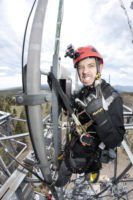By Alyssa Stahr
While tower rescuers may get most of the glory, the people working behind the scenes providing equipment and services to the rescuers certainly deserve some of the credit. Jacob Wallace’s parents were janitors 20 years ago, cleaning buildings at night. They eventually shifted to solely selling janitorial supplies.
To avoid competing with bigger companies like Wal-Mart and Home Depot, they ended up specializing in professional window cleaning equipment in the early ‘90s. Since then, they’ve become the world’s largest supplier of professional window cleaning equipment.
The company started carrying safety equipment for high rise building cleaners, who were utilizing a specialized version of rope access and rope descent work. In 2005, the Wallaces decided they wanted to reach out to other markets. A new division, Rope + Rescue, started catering to the telecom industry and began carrying equipment specifically for tower climbers and technicians.
Rope + Rescue also works with various training companies, supplying recommendations of reputable companies they’ve worked with.
“When people are asking what they need for a rescue plan, the rescue kit is just one component of that,” Jacob Wallace said. “Some people just want to buy the rescue kit and think that they are covered. That doesn’t do much good unless you know how to use it.”
A common issue Wallace noted, is someone will buy a rescue kit, but then won’t get the proper training on the specific configuration of the kit that they purchased. A high-stress situation like a rescue without proper training hasn’t led to a bad outcome yet, Wallace said, but it has extended the time that the rescue took.
“With that, practice is just such a huge component. You can’t do it one or two times a year and then expect in a high-stress situation that they’re still going to know what to do,” he said. “You really have to get down to the point to where it’s more muscle memory.”
Wallace shared that a tower crew he recommends practices every month. They performed an actual rescue recently in under 15 minutes. He said that rope access is a huge plus in training.
“If any tower technician were to get SPRAT or IRATA trained, they would become a much more effective tower technician. They would know how to do a lot more techniques that would make them more efficient in their day-to-day work, and they’d be safer,” he said.
As for new equipment, Wallace is excited about more safety and smaller and lighter devices. Customers traditionally don’t trust lighter items and want bigger and bulkier items that make them feel safer.
“It’s a shame because there’s a lot of great equipment available that would make their life a lot easier. If you could carry a one-pound item up the tower instead of a five-pound item, I know which I’d rather be carrying,” he said. “When you use a smaller rope you have a bigger selection of devices that will work with that rope. In my opinion a lot of the devices that work with smaller rope are better, they’re more efficient and they’re safer. A lot of times with the bigger, bulkier stuff you’re carrying more weight than you need to, you’re spending more money than you need to and you’re not using as efficient as devices as you could be.”
In particular, Wallace is excited about the new set of fall protection gear that Petzl is coming out with this year.
“They’ve got a new tower harness; they just released their set of double lanyards,” he said. “Petzl is an example of what I was talking about, where you can get the smaller, lighter and arguably better equipment. You have to retrain to trust the equipment, but their stuff is absolutely top-notch, and we’re really excited about that.”
Rope + Rescue’s Colorado headquarters provide 18,000-square-feet of space, including a walk-in area where customers can get their hands on the equipment and try on harnesses. The company’s fulfillment center is 5,000-square-foot of space in North Carolina.
To see Wallace’s video advertised during February’s NATE show, Rescue Plans for Height Work, visit YouTube.
For more information, visit http://www.ropeandrescue.com/.






Reader Interactions